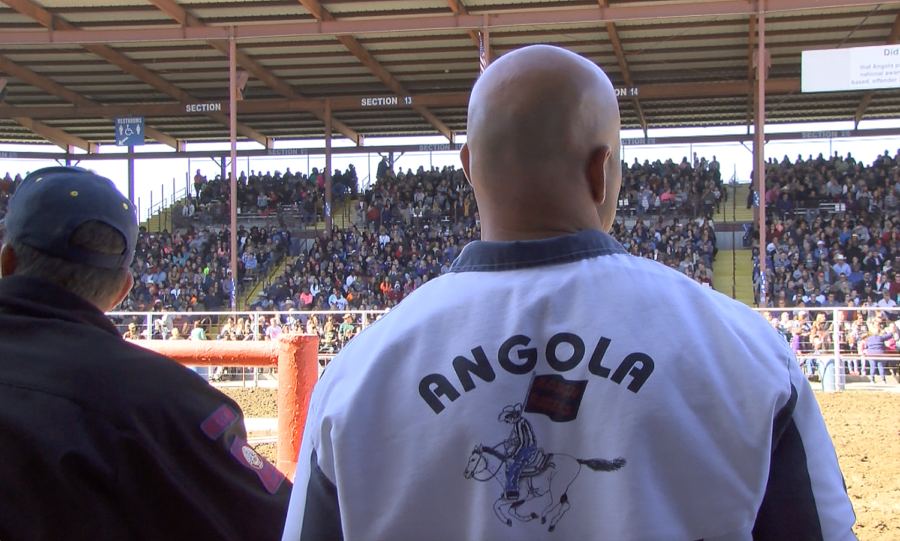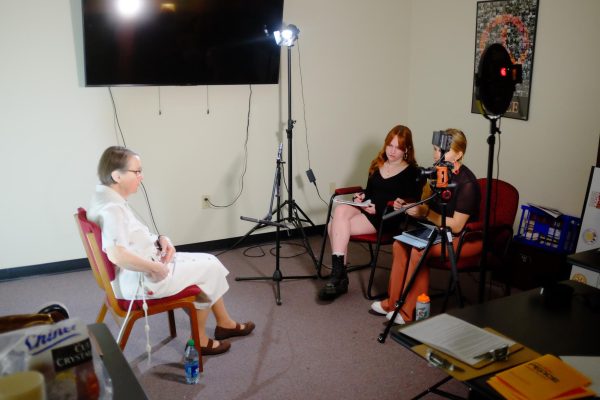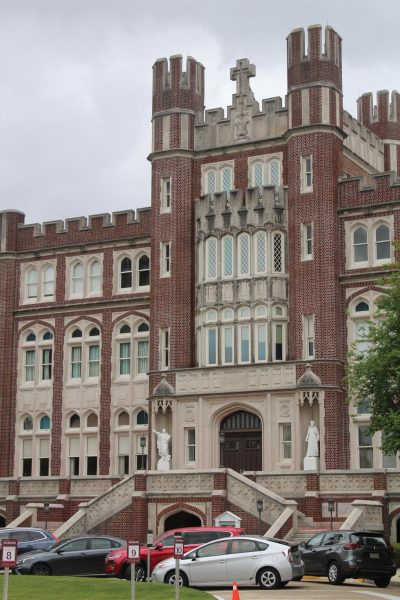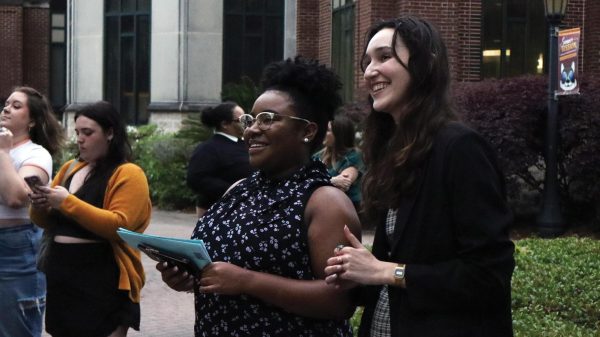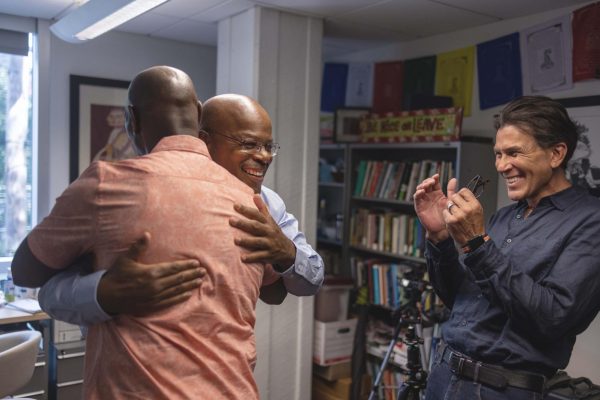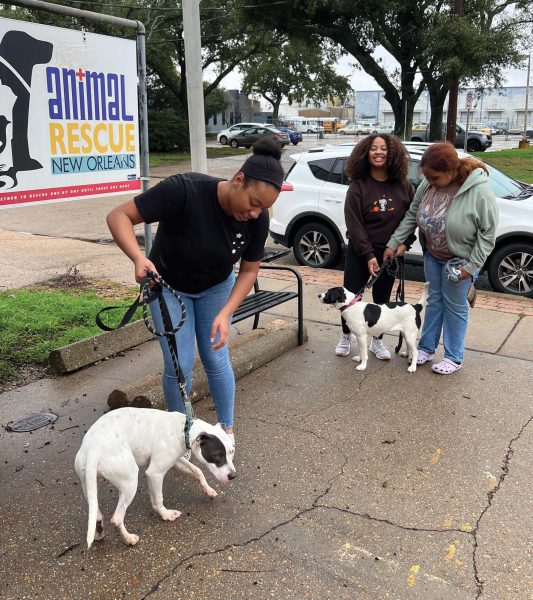Prisoners look to life after incarceration through reentry program
An unidentified prisoner stares out into the crowd of free people at the Angola Rodeo. Almost half of all Louisiana convicts return to prison within five years of their release, a problem that reentry programs like the one at the Louisiana State Penitentiary aim to fix. Photo credit: Andrew Callaghan
November 10, 2017
Louisiana is the most incarcerated state in the most incarcerated country in the world. At 776 per 100,000 people incarcerated, Louisiana sits well ahead of the rest of the United States.
Under the leadership of Democratic Gov. John Bel Edwards, the state legislature is trying to strip Louisiana of its dubious ranking. In his campaign for governor, Edwards promised that the state will lose that designation by 2019.
On Nov. 1, a package of state legislation went into effect, retroactively cutting mandatory minimum sentences and making more inmates eligible for parole or early release. The Louisiana Justice Reinvestment Package aims to reduce prison populations by 10 percent and save the state at least $262 million over the next decade.
However, getting over-sentenced offenders “out” is only half the battle — the next challenge is keeping them out. According to the Louisiana Department of Public Safety and Corrections, of the 15,000 offenders who are released from Louisiana prisons each year, 43 percent of them will return to prison within five years.
Marcus M. Kondkar, chairman of sociology at Loyola, studies Louisiana’s prison system at Louisiana State Penitentiary, better known as Angola.
“The majority of them have to depend on the kindness of friends and family,” Kondkar said. “You can see how they sometimes feel that they have no choice to go back to what they were doing to make a living, which very often involves criminal behavior.”
Using the money that will be saved through incarcerating fewer people, state officials plan to invest more money into expanding its reentry programs. However, due to the state’s current debt — which exceeds $32 billion — these funds won’t be available for investment until late 2018.
“The folks getting released right now, they’re on their own,” Kondkar said.
This vow to strengthen reentry programs comes in the wake of the success of a program called Reentry Court, which was spearheaded by Orleans Parish Criminal District Court judges Arthur Hunter and Laurie White. The Reentry Court sends offenders through a small-scale reentry program at Angola.
Of the 131 ex-convicts who have graduated from the program since 2010, only 13 percent of them have returned to prison within three years.
Through this rigorous reentry program, which is the first of its kind in the state, Angola has been successful in preparing offenders for a crime-free life on the outside.
Gary Young, associate warden for programming at Angola, said that adequately preparing offenders for a life on the outside takes more than training them in a trade skill.
“We call it the 90-10 rule. We’ll spend 90 percent working on moral rehabilitation programming, changing the heart,” Young said. “The other things come easy. That’s the hard thing to change.”
In the program, offenders are given guidance and taught trade skills. Each participant is paired with an older “mentor,” an inmate serving a life sentence.
Offenders can be trained in a variety of vocations, such as mechanics, construction or culinary arts. In addition to receiving drug and alcohol treatment, they take “life skills” courses in subjects like finance, parenting and anger management. In order to complete the program, they must receive two certifications in their vocational field and pass a high school equivalency test.
When participants are ultimately released from prison, they are connected with an employment agent and set up with a place to live. Many are connected with pro bono lawyers. Their families are even offered psychiatric counseling.
John Sheehan, 52, is serving a life sentence for second-degree murder. He works as a mentor in the reentry program, where he teaches automotive technology. His former mentee, David, earned several General Motors certifications in Angola. Now he works for a Chevrolet dealership in New Orleans and takes classes hands-on at Delgado Community College.
“We aren’t teaching them to flip burgers. When you make 20-30 an hour, there is less anxiety. You don’t have to worry about how to make the insurance payment or the car payment or things like that,” Sheehan said. “Not only do we teach them during the day, we live them at night. We monitor their behavior. If we see something going wrong or see them making a bad choice, we can pull them aside and say, ‘you need to rethink this’. We have to live our lives in an exemplary way for them.”
Sheehan believes that nobody should be defined by the worst mistake in their life. For him, training mentees is a way he can give back to society.
“The future of corrections is reentry. That’s where successful interventions happen or could happen,” Kondkar said.
However, Kondkar believes that not enough offenders are accepted into the program. Out of the hundreds of people released from Angola each month, only a few dozen of them have completed the reentry program.
“There are definitely not enough. In order to become eligible for it, a judge has to make you eligible for it. A judge has to deem you a good candidate, you can’t just say, ‘please get me some reentry services’,” Kondkar said. “The elite manage to get into these things. A lot of people avoid them because if you fail, drop out or something happens, you recidivate; you can be tried as a habitual offender.”
In order to be considered by the Reentry Court, the candidate must plead guilty to a non-violent, non-sex crime, which carries a sentence of 10 years or less. After that, they must be deemed a “good candidate” by the court.
In addition, around half of the program’s participating offenders won’t graduate. Of the 357 who have participated in Angola’s reentry program since it began, 172 of them have been removed for disciplinary violations.
Daniel Tapia, case manager for Orleans Parish Criminal District Court’s Reentry Program, was sentenced to life imprisonment for manslaughter but was later paroled. Now he works directly with ex-convicts from the Reentry Court program. He helps them to find fair-paying, secure jobs in their area of interest.
Tapia is a strong supporter of Angola’s program. However, he thinks that to make a true impact, the court must open its doors to violent offenders.
“Everybody is scared of what it’s going to look like to the public if you lock up ‘violent offenders’ because of the stigma. If you only offer services and help to those who are ‘non-violent,’ you are leaving a whole population of people coming home with no help. You’re leaving them in a position where if they can’t figure it out here on their own, they have no choice but to go to what they know,” Tapia said.
Without adequate reentry services, offenders often face crippling roadblocks as they try to integrate back into society. They must rely on the support of friends and family, many of whom may be estranged or living in poverty.
In addition, many offenders leave prison to discover they owe tens of thousands of dollars in child support debts to the federal government. When offenders are incarcerated, the state pays their child support payments. Upon release, though, offenders must pay it all back to the state.
“They are working just to pay the state. They look for ways to support themselves and make money without the state being able to take it from them directly out of their check, and that’s when they end up back in trouble,” Tapia said.
Legally, if someone owes child support, the Louisiana Department of Licensing can withhold them issuance of a driver’s license. With no valid identification, you cannot sign a lease, drive a car or get a job.
“You end up putting people in situations that almost look as though are designed to set them up to fail. It’s not designed that way, but it’s an unintended consequence of the way we’re doing reentry,” Kondkar said.


